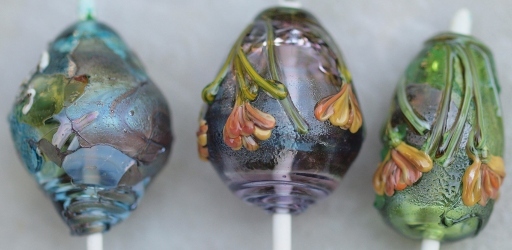These three beads encompass a variety of experiments, one of which—making large hollow beads with no kiln—failed. —They all cracked. Le sigh.

Three experimental beads. Center one measures 39x33mm. Note amber and aqua shards on left side of leftmost bead: these are Double Helix. Also note left and right portions of 254 shard, the right side being overlapped with Ag plum.
(Actually, I neglected to photograph the first one in the series, which really is rather ugly, so of course it was the one I flame annealed the most carefully; thus, it's survived. Guess mebbe I should've taken the trouble with these, which I liked better.) In any event I played with several techniques. One was mounting shorts on a 1/8" puntile to make a nice big gob of glass, which is much easier to make into a large vessel. Using different colored shorts gives additional interest to the base bead as well. After melting it down, I transfered it to a standard 7mm rod, in case I ran out of glass.
First I made the bead not shown; of the ones depicted, I made middle bead first, then the one on the right, and finally the one on the left, and for each one, added a technique:
- new cane/shorts gob (bead not shown)
- transparent thompson enamel
- shards
- shards out of double helix; silvered ivory stringer
All 4 beads were made using a technique of mounting up super-shorts of 2–3" upon a 1/8 puntile, melting them together, mounting one end onto a rod, then pulling off the other puntile, and using the gob—generally 12–14mm thick and about an inch long—to make the base bead. I used light to medium cobalts, pale amethyst, pale aquamarine and 25–50% CLC for the beads on the left, and some grass greens and clear for the one on the right (which didn't show nearly as much color variation).
Both florals shown include the new cane: the middle vase has it as the outermost petals, and the bead on the bead on the right as the three interior petals. This cane is the striking terracotta 262 powder pink, with a patch of fairly standard coral on one side, bracketed with the pea (yellowish) green. The powder pink is cased in gold ruby, the remainder in transparent pink. The green looks nasty, (probably not helped by being cased in pink instead of grass green, but I wanted to see if I could get away with that) but the basic concept might be nice for a fall floral. I'm guessing the golden tan is probably some double helix terranova pulled out into a stringer.[1]
And yes, I tried the softer flame/more gentle application and yes, it even worked. Thanks, Leah. (She mentioned using a bushy flame to do her florals at her Gathering presentation.)
So much for that. Then I figured I'd add some interest to the subtle variations coming out of the hand-mixed glass for the base bead by putting on some of the "new"[2] transparent thompson enamels, specifically a light blue and green...
Then, liking the orange peel texture, I decided to dig out my shards, and made the green bead. —Figured since the silver plum does such nice things, perhaps the even more expensive double helix colors—in this case the dark aqua and terranova would too. The aqua blew out beautifully. The terra nova was a bear, and I recommend not trying to save money by putting a transparent collar of clear around the blowpipe—make the whole bubble out of terranova, or at the very least, use a stiff glass, like black; I had to blow that stupid bubble out three times before I got it to work.
Unfortunately the double helix didn't do much. Perhaps if the bead hadn't been giving me fits by cracking, I might've had more luck. However, I put some Ag plum on top of this devitted pink stuff (which I then realized was 254) and that overlap was very pretty, as you can see in the photo. Also tried some leftover silvered ivory stringer, which looked like...silvered ivory stringer. This probably would be great fun on a transparent red or orange, but it was boring on grass green.
However, I liked the 254/Ag plum discovery (which I didn't make till photographing the bead, actually) the bead wasn't a complete waste of time.
Unless otherwise noted, text, image and objects depicted therein copyright 1996--present sylvus tarn.
Sylvus Tarn